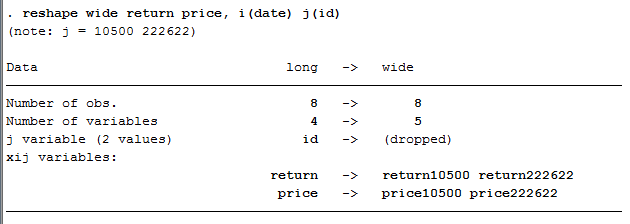
The Stata reshape command apparently relies on this naming convention.

In our case that’s day (day1, day2, da圓). After that you specify the word kernel that the multiple columns we want to reshape have in common. To reshape a wide data set long, you have to specify reshape long. Afterward we rename our two new columns to match the output from the other examples. Stata offers the reshape command for restructuring data. Use the i() option to supply the variable that uniquely identifies records in the wide data set and use the j() option to supply the name of the variable that will store the numbers from the day1, day2, and da圓 column headers. Therefore below we assign the day values to a column called “time”. So we can’t just name our column containing the day number “day”. However Stata uses that common word kernel as the name of the new column containing the gathered values. In our case that’s “day” (day1, day2, da圓). Stata offers the reshape command for restructuring data. Listed after the arguments are the columns to be reshaped. The key argument takes the name of the column that will contain the column headers while the value argument takes the name of the column that will contain the gathered values. The tidyr function gather does the same thing but has a slightly different syntax. That is, the column headers are turned into variables and the values in the columns are gathered into one column. All variables not listed as id.vars are reshaped. These are the variables that will remain after reshaping. The basic way to use it is to indicate the id.vars. The reshape2 package has the melt function. While base R has a reshape function, we think it’s easier to use the reshape2 or tidyr packages.

It’s identical to the wide format data displayed above.
#RESHAPE LONG STATA CODE#
Feel free to download the file and try the code below. In each case we assume you’re starting with a csv file called dat.csv. How do you reshape wide data to long? Below we give basic demonstrations using R, SAS, SPSS and Stata to perform the reshaping demonstrated above. To do the same with the wide data would mean dropping the day1 and day2 columns after subsetting. We could subset the long data above to easily see all amounts on day 2 for males with race = 0 and trt = 1. Storing data in long format also allows us to quickly subset our data without dropping columns. It’s actually embedded in the column headers of day1, day2 and da圓. In the wide format, there is no explicit variable for day. Code: unab stubs : m1 local stubs : subinstr local stubs 'm1' '', all reshape long stubs, i (recordid) j (time) string destring time, replace ignore (2m) 1 like. For example, the long format allows us to include a variable for day in our model. Other users who have found the question cross-posted are encouraged to share the links as a reply as well.An advantage to having data in long format is that graphing and statistical modeling are frequently made easier.
#RESHAPE LONG STATA HOW TO#
See the sticked "READ ME: How to best ask for help in /r/Stata" post on how to comment here if all else fails. Make sure to include the word "Stata" in your search query. Perform a web search for your question prior to posting here. Stata's online community has been active for many years and many questions and solutions are documented on StataList, which are highly indexed on contemporary search engines (e.g., Google). Stata has extensive and complete documentation you can read before posting here (and you can type help followed by the command name in console to see it, e.g. This is not a place to find Stata tutoring.

Do not request that the /r/Stata community do your homework for you. Faster implementation of Stata's collapse, reshape, xtile, egen, isid, and more using C plugins - GitHub - mcaceresb/stata-gtools: Faster implementation of Stata's collapse, reshape, xtile, egen.

Assume good faith questions and comments. Follow this answer to receive notifications. Here is an example: clear set obs 10 gen schid n gen mi 1 gen mii 2 gen miii 3 reshape long m, i (schid) j (teacherid) string encode teacherid, gen (teacherid2) Share.


 0 kommentar(er)
0 kommentar(er)
